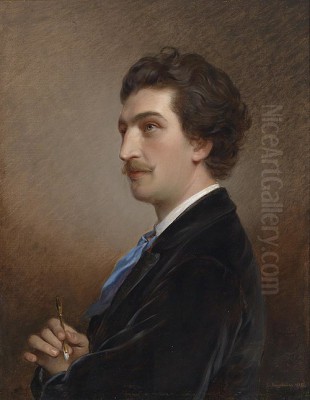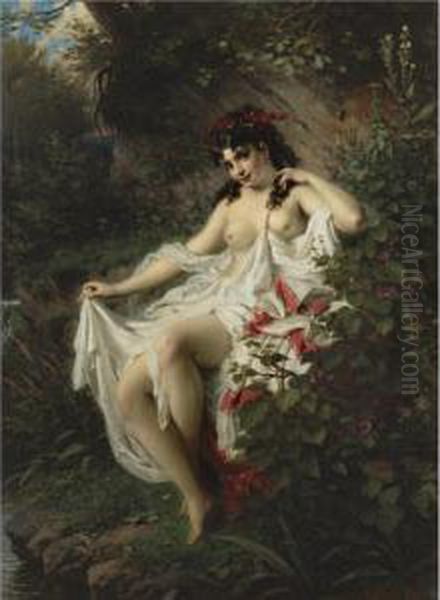
Anton Ebert stands as a notable figure in the Viennese art scene of the latter half of the 19th century. Active during a period of significant cultural and artistic flourishing in the Austro-Hungarian capital, Ebert carved a niche for himself primarily as a painter of portraits, particularly those of women and children, though his talents also extended to landscape and genre scenes. His work is often characterized by a blend of academic precision and a sensitive portrayal of his subjects, capturing a sense of warmth, charm, and quiet dignity.
Early Life and Artistic Formation
Anton Ebert was born in 1845 in Kladruby (Kladrau) Castle, Bohemia, which was then part of the Austrian Empire (now the Czech Republic). His birthplace connected him to the noble Windisch-Graetz family, suggesting an early exposure to aristocratic circles that would later become patrons of his art. His formal artistic training began in Prague, likely at the Academy of Fine Arts, where he would have received a foundational education in drawing and painting according to the academic standards of the time.
Seeking further refinement, Ebert moved to Vienna, the vibrant heart of the empire's art world. There, he sought private instruction under the tutelage of Ferdinand Georg Waldmüller (1793-1865). Waldmüller was a towering figure in Austrian art, renowned for his Biedermeier realism, his meticulous attention to detail, his mastery of light, and his often unsentimental depictions of everyday life and landscape. Studying with Waldmüller, even if privately and potentially towards the end of the master's life, would have profoundly impacted Ebert's technique and artistic outlook, instilling in him a respect for careful observation and skilled execution.
Further broadening his horizons, Ebert reportedly undertook several study trips, a common practice for aspiring artists of the era. These journeys would have exposed him to different artistic traditions and landscapes, enriching his visual vocabulary and technical repertoire before he settled into his professional career.
A Career in Vienna: Portraiture and Recognition

Upon establishing himself in Vienna, Anton Ebert quickly gained recognition as a skilled portrait painter. His ability to capture not just a likeness, but also the personality and inner life of his sitters, made him a sought-after artist. He became particularly known for his depictions of young women and children, subjects he rendered with sensitivity and grace. His portraits often convey a sense of intimacy and warmth, highlighting the gentle expressions and fashionable attire of his subjects.
In 1862, Ebert became a member of the prestigious Vienna Künstlerhaus, the association of Austrian artists. Membership signified professional recognition and provided opportunities for exhibition and networking within the Viennese art community. This affiliation placed him firmly within the mainstream of the city's artistic life during a dynamic period that saw the rise of Historicism and the grand projects of the Ringstrasse era.
Ebert's clientele likely included members of the Viennese bourgeoisie and aristocracy, circles perhaps accessible through his early connections. His skill was even recognized at the highest level; he is known to have painted a miniature portrait of Emperor Franz Joseph I, a commission that speaks volumes about his standing and reputation as a portraitist within the imperial capital.
Artistic Style and Thematic Focus
Anton Ebert's style is rooted in the academic realism prevalent in the mid-to-late 19th century, clearly influenced by his training under Waldmüller. His works demonstrate meticulous draftsmanship, a smooth application of paint, and careful attention to texture and detail, particularly in rendering fabrics, hair, and skin tones. He possessed a strong sense of composition, arranging his figures in natural yet elegant poses.
A distinctive aspect noted in some descriptions of his work is his portrayal of female figures, sometimes described as having a fuller, "slightly plump" physique. This characteristic is highlighted as running counter to a modern "thin is beautiful" aesthetic, suggesting Ebert embraced a more classical or perhaps Rubenesque appreciation for the female form. His women are depicted not merely as objects of beauty but as individuals possessing confidence, charm, and inner poise. They often appear in domestic or idyllic natural settings, embodying contemporary ideals of femininity and grace.
While portraiture was his mainstay, Ebert was also a capable landscape and genre painter. His landscapes often served as backdrops for his figural compositions, creating harmonious settings that enhanced the mood of the portrait. Works with titles suggesting genre scenes, like Playtime in the Kitchen, indicate an interest in depicting charming vignettes of everyday life, often involving children, a theme popular during the period. His ability to combine figural painting with landscape elements allowed for richer, more narrative compositions.
Ebert's use of color was typically harmonious and rich, employing a palette that effectively conveyed mood and described form. His lines are often described as fluid, contributing to the overall elegance and appeal of his paintings. There's a consistent classical undertone or sensibility in his work, a pursuit of balanced beauty and refined execution that aligns with the academic traditions he inherited.
Notable Works
Several works are cited as representative of Anton Ebert's oeuvre. Among the most frequently mentioned are:
_An Oriental Beauty With Fruit_: This title suggests a work participating in the 19th-century fascination with Orientalism. It likely depicts a woman in exotic attire, perhaps surrounded by luxurious props like fruit, showcasing Ebert's skill in rendering textures and rich colors while engaging with a popular theme of the era. Such paintings often blended portraiture with genre elements.
_Spring In The Woods_ (or similar titles like The Beautiful Spring): This work points towards Ebert's engagement with landscape and possibly allegorical themes. It likely features figures, perhaps young women or children, situated within a blossoming woodland setting, evoking the freshness and renewal associated with springtime. It would demonstrate his ability to integrate figures seamlessly into natural environments.
Other potential works, such as Playtime in the Kitchen, further illustrate his interest in genre scenes focused on the charm of domestic life and childhood. Across these examples, Ebert's consistent focus on graceful figures, detailed rendering, and harmonious compositions is evident.
Contemporaries and Artistic Context
Anton Ebert worked during a vibrant period in Austrian and European art. His career in Vienna placed him amidst a constellation of talented artists. Understanding his contemporaries helps contextualize his position within the art world of his time.
One of the most dominant figures in Vienna during Ebert's active years was Hans Makart (1840-1884). Makart's opulent, theatrical style, known as "Makartstil," defined an era and heavily influenced decorative arts. While Ebert's style was generally more restrained and focused on intimate portraiture, he undoubtedly worked in the shadow of Makart's immense fame.
Other notable Austrian contemporaries included Leopold Carl Müller (1834-1892), known for his Orientalist scenes painted with ethnographic accuracy, and Emil Jakob Schindler (1842-1892), a leading figure in Austrian atmospheric landscape painting (Stimmungsimpressionismus), alongside artists like Olga Wisinger-Florian (1844-1926) and Tina Blau (1845-1916), who were also prominent landscape painters. Schindler's focus on mood and light in landscape offered a different path from Ebert's more figure-centric work.
In the realm of portraiture, Ebert followed in the tradition of earlier Viennese masters like Friedrich von Amerling (1803-1887), whose elegant Biedermeier portraits set a high standard. Although Amerling belonged to an older generation, his influence persisted.
Genre painting was also popular. August von Pettenkofen (1822-1889) was known for his scenes of Hungarian and Slavic peasant life. While Ebert also painted genre scenes, his focus remained more on bourgeois or idyllic subjects.
Looking slightly beyond Austria, but within the broader German-speaking world and relevant academic traditions, Eduard von Grützner (1846-1925), a German painter often associated with Munich, specialized in humorous genre scenes, particularly those featuring monks, showcasing a different facet of 19th-century genre painting.
Johann Baptist Reiter (1813-1890), an Austrian painter active slightly earlier but overlapping with Ebert's early career, was known for his Biedermeier portraits and genre scenes, representing the tradition from which artists like Ebert emerged, though Reiter's dates and primary focus differ slightly from some initial descriptions.
French artists mentioned as contemporaries, like Jules Emile Saintin (1829-1894), known for portraits, genre scenes, and American subjects, and Lucy Briquet (dates often cited as 1849-1922, though less prominent), known for animal paintings, represent the wider European artistic landscape. While direct collaboration or exchange between Ebert and these specific French artists is not documented based on the provided context, their work reflects the diverse artistic currents circulating across Europe, accessible through exhibitions, publications, and travel.
It is important to note that while these artists were contemporaries, sharing the same historical period, direct personal or professional interaction between Ebert and many of them (especially Reiter, Briquet, and Saintin) is not specifically recorded in the available information. However, they collectively formed the rich artistic milieu in which Anton Ebert developed his career, representing the various styles and thematic concerns – from grand history painting and atmospheric landscape to intimate portraiture and detailed genre scenes – that characterized the late 19th century. Ebert navigated this landscape by focusing on his strengths in refined, charming portraiture.
Legacy and Reception
Anton Ebert passed away in Vienna in 1896. He left behind a body of work appreciated for its technical skill, elegance, and sensitive portrayal of subjects, particularly women and children. While perhaps not reaching the revolutionary status of some avant-garde figures who emerged towards the end of his life (like the artists of the Vienna Secession, founded just a year after his death), Ebert represents the enduring appeal of academic portraiture in the late 19th century.
His work captured a specific aspect of Viennese society – its grace, its appreciation for domesticity, and its adherence to established standards of beauty and artistic execution. The recurring mention of his depiction of fuller-figured women offers an interesting counterpoint to evolving beauty standards and highlights his particular aesthetic sensibility. His connection to the nobility through birth and his commission from the Emperor underscore his success within the established social and artistic structures of his time.
Today, Anton Ebert's paintings appear periodically on the art market and are held in various collections. They continue to be admired for their charm, craftsmanship, and as valuable documents of the tastes and appearances of Viennese society during the late Habsburg era. He remains a respected, if perhaps secondary, figure within the rich tapestry of 19th-century Austrian art.
Conclusion
Anton Ebert was a talented and successful Austrian painter of Bohemian origin, whose career unfolded primarily in the imperial capital of Vienna. Trained in Prague and under the influential Ferdinand Georg Waldmüller, he excelled as a portraitist, favored for his elegant and sensitive depictions of women and children. A member of the Vienna Künstlerhaus and recipient of an imperial commission, he achieved considerable recognition in his lifetime. His style, rooted in academic realism, emphasized detailed execution, harmonious color, and the capturing of his subjects' character and charm. Works like An Oriental Beauty With Fruit and Spring In The Woods showcase his thematic range, encompassing portraiture, Orientalism, landscape, and genre elements. Situated among contemporaries like Hans Makart, Emil Jakob Schindler, and others, Ebert carved his own path, contributing significantly to the Viennese portrait tradition of the late 19th century with works that continue to resonate with elegance and skillful artistry.